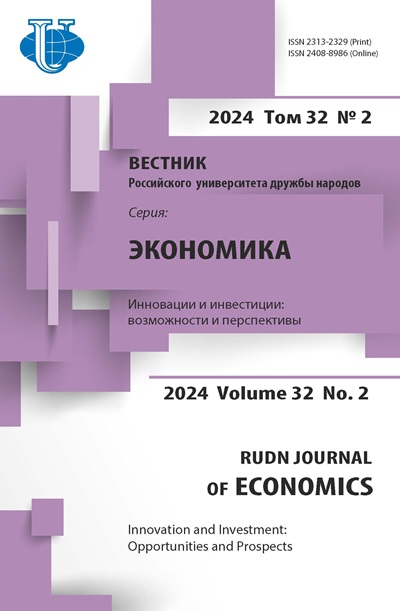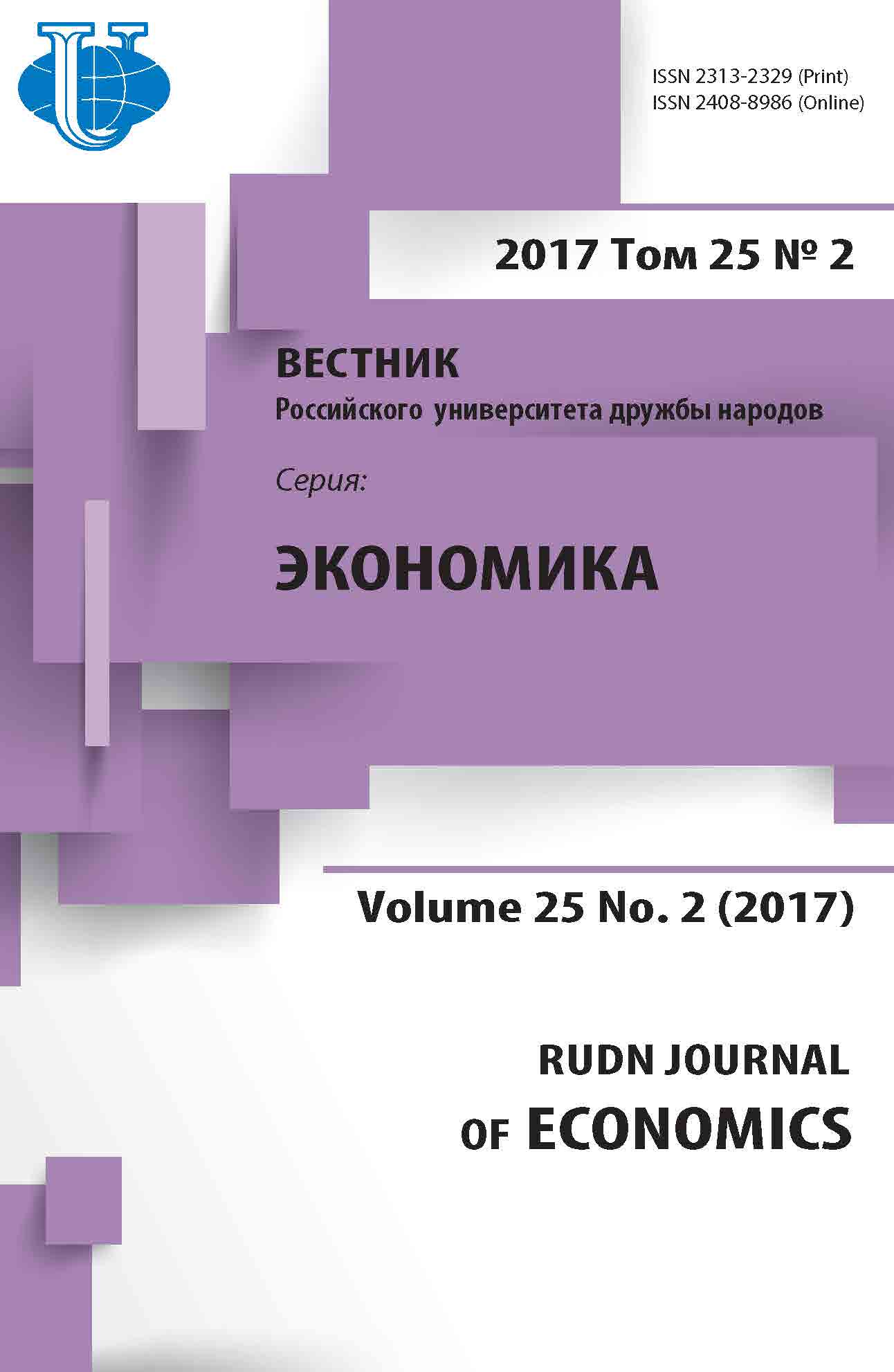Vol 25, No 2 (2017)
- Year: 2017
- Articles: 12
- URL: https://journals.rudn.ru/economics/issue/view/1019
- DOI: https://doi.org/10.22363/2313-2329-2017-25-2
Full Issue
Articles
REGIONAL INTEGRATION IN AFRICA: DYNAMICS OF INTRA-REGIONAL TRADE 1990-2015
Abstract
The paper studies the changing role of regional communities in the formation of trade flows of intra-regional trade of Africa in the last 25 years. It’s revealed that the growth of intra-regional trade turnover of the majority of regional integration groupings reduction of the share in world’s trade and the growth of intra-regional trade turnover. Commodity structure of integration groupings in intra-regional trade is more diversified, than in international trade.
 159-167
159-167


INTERNAL THREATS TO ECONOMIC SECURITY OF THE EURASIAN ECONOMIC UNION
Abstract
The relevance of the study is due to the fact that the Eurasian Economic Union in the modern global economy is the second economic union in the history of the development and existence of integration processes. It is one of the largest regional markets, which unites about 182.7 million people, it possesses the fifth part of the world’s gas reserves and 15% for oil, with total GDP of about 2.5 trillion dollars (about 85% of GDP in all CIS countries), the industrial potential of 600 billion dollars and the volume of agricultural production - 112 billion dollars, etc. Thus, the potential of the new integration association is unique. The question today is whether the five countries will be able to find common ground in their general economic interests to preserve the association and its further development, as well as through the accession of new post-Soviet countries. The Eurasian Economic Union can potentially become one of the most important subjects of the world economy, a regional and even a global leader, if the association secures its economic safety, or put in other words will ensure the positive economic effect for each member country. The purpose of this article is to identify internal threats to the economic security of EAEU. The study showed that the most important internal threats to economic security are: the differentiation of the economic development of member countries; preservation of raw material export model of the development in Russia and Kazakhstan; virtually no trade and investment cooperation between such pairs of countries as Belarus - Armenia, Kazakhstan - Armenia, Kyrgyzstan - Armenia, Belarus - Kyrgyzstan, Kazakhstan - Belarus; aggravation of member countries financial problems; discrepancy in transport infrastructure development to the current needs of the integration association; absence of a single payment system; absence of a system of general integration of economic interests, divergence of the member countries interests up to the opposite position. Taking into account the material analyzed and the results obtained, the conclusion was drawn on the need to develop mechanisms for neutralizing these threats.
 168-177
168-177


THE INFLUENCE OF GLOBALIZATION ON HIGHER EDUCATION AND THE POTENTIALS OF LEBANON
Abstract
 178-188
178-188


RUSSIAN-EUROPEAN INVESTMENTS: DYNAMICS AND STRUCTURE IN TERMS OF SANCTIONS
Abstract
The paper characterizes the main trends of direct investment from the EU to Russia in connection with the introduction of the EU anti-Russian sanctions. The author analyzes the dynamics of foreign direct investment from European Union countries in the Russian economy, their industry structure. On the basis of the conducted analysis the author comes to the conclusion that in 2014-2016 the existing problems in the investment relations between the European Union and the Russian Federation to a significant extent, are not the direct result of the sanctions. The sanctions only exacerbated tensions that had already formed at the turn of the century.
 189-198
189-198


HISTORY OF POVERTY REDUCTION INITIATIVES IN GREAT BRITAIN
Abstract
The article deals with the problem of poverty and social inequality in Great Britain both now and in historical retrospect. The author analyses some major works of prominent philosophers and economists of the late 18th and early 19th centuries.An effectiveness analysis of the British government’s efforts to eradicate this phenomenon is presented. The author also provides the outlook of anti-poverty activities of non-governmental organizations.
 199-208
199-208


THEORETICAL APPROACH TO THE SOCIALLY ORIENTATED BUSINESS POLICY
Abstract
 209-218
209-218


SYSTEMATIZATION OF THE APPROACHES ASSESSING SOCIO-ECONOMIC DEVELOPMENT OF THE COUNTRIES BY USING WELFARE INDEX
Abstract
Nowadays there is a lack of a unified approach to the welfare definition and methods for its assessment, therefore this article combines different welfare indices, analyzes their features, as well as the indicators that they include.The classification of these indices in accordance with the three theoretical approaches is suggested: objective, which is based on the statistical data; subjective, which is based on the subjective opinion of the population and objective-subjective, which combines both of the above mentioned approaches. The relevance of well-being indices is analyzed; it is also proven the interrelation of well-being indices with the traditional socio-economic indicators. It is defined that the correct assessment of well-being achieved by using objective-subjective indices, which take into account the statistical data as well as subjective opinion of the population.
 219-232
219-232


METHODICAL ASPECTS OF FORMATION OF THE ADAPTIVE MECHANISM OF SUSTAINABLE DEVELOPMENT OF THE ENTERPRISE ON THE BASIS OF A TARGET INTEGRATED APPROACH
Abstract
Now most the enterprises are characterized by low degree of adaptability to rapid changes of external and internal environment, inability to reach continuous dynamic high-quality change of quantitative indices, to carry out an objective complex assessment of extent of the development. The activity of the enterprises based on the principles of sustainable development will promote the solution of these problems. For sustainable development the enterprise needs to define accurately the purposes of the existence, an algorithm of consecutive actions, ways and methods of their achievement, i.e. to develop the mechanism (the mechanism of sustainable development) which will allow not only to adapt to environment conditions, but also to develop effectively.
 233-241
233-241


ESTIMATION OF BANKRUPTCY RISK OF SMALL BUSINESS COMPANIES BASING METHODS OF MACHINE LEARNING
Abstract
The article deals with the methodology for constructing an algorithm for determining the probability of bankruptcy of an enterprise using machine learning methods. The advantage of this methodology is the use of not only quantitative, but also qualitative indicators of financial stability of business entities, as well as the possibility of excluding factors that have little effect on the final rating. It is assumed that the created mathematic model will be useful to representatives of small and medium-sized businesses and will provide an objective and precise picture of the financial situation of the enterprise, including current threats and the risk of bankruptcy.
 242-254
242-254


FEATURES OF CREDIT RATING ASSESSMENT OF ISLAMIC INSURANCE COMPANIES BY RATING AGENCIES
Abstract
The Global market of Islamic Insurance shows stable growth and development. In 2015 the volume of Global takaful market reached $23.3 billion. In comparison with 2006 year when takaful sphere reached $5 billion it increased for $20 billion. However takaful sector has a lot of indeterminate regulatory questions because it’s young branch of global finance. The article describes the takaful framework and the dynamics of its development. There is considering credit rating’ assessment principles, rating agencies’ different positions concerning credit rating’ assessments. Also in the article considered methods of improvement credit rating assessments of takaful-companies.
 255-262
255-262


IMMIGRANT LABOUR IN BRAZIL (2007-2015): THE LEGAL AND THE UNDOCUMENTED CIRCUITS
Abstract
 263-274
263-274


LABOR MIGRATION FLOWS FROM VIETNAM TO THAILAND IN THE CONTEXT OF ASEAN REGIONAL INTEGRATION
Abstract
 275-282
275-282















